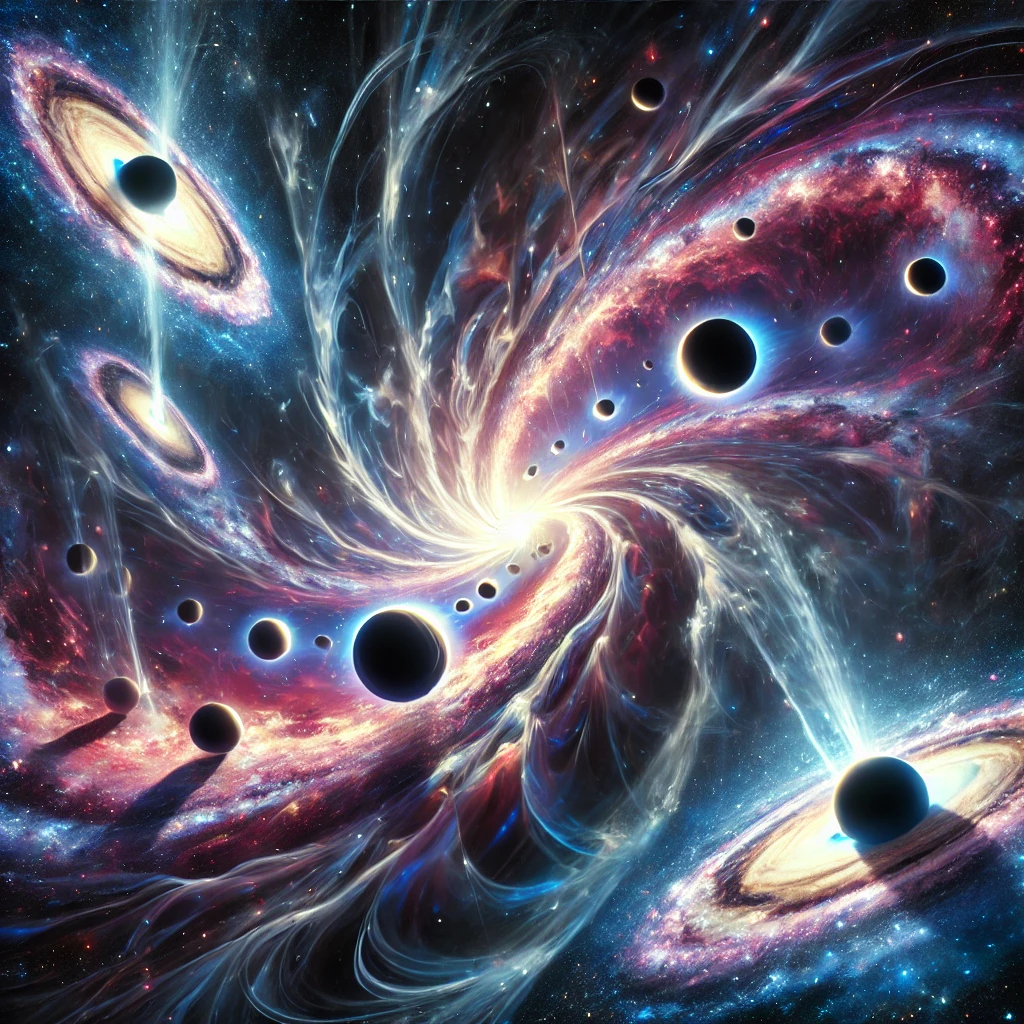Black Holes as the Fundamental Force of the Universe: An Alternative to Dark Matter and Dark Energy
Publicado em 2025-03-21 21:28:39

Author: Francisco Gonçalves
Email: francis.goncalves@gmail.com
Abstract
The standard cosmological model assumes the existence of dark matter and dark energy to explain the accelerated expansion of the universe. However, these entities have never been directly detected. In this paper, we propose that primordial black holes (PBHs) and black holes formed throughout cosmic time are the primary gravitational engines of the cosmos. We argue that PBHs can replace the need for dark matter, and the energy released by black holes may be responsible for both the acceleration and the potential deceleration of cosmic expansion. Recent data from the Dark Energy Spectroscopic Instrument (DESI) suggests that dark energy may be weakening, indicating a possible reversal of the universe's expansion—leading to a Big Crunch. We present observational predictions that could test this hypothesis and potentially redefine the standard cosmological model.
1. Introduction
The ΛCDM model posits that approximately 27% of the universe is dark matter and 68% is dark energy (Planck Collaboration, 2018). Dark matter was introduced to explain galactic rotation curves (Rubin et al., 1980), and dark energy to justify the accelerated expansion of the universe (Riess et al., 1998).
Despite decades of research, no direct detection of dark matter has occurred in experiments like LUX or XENON1T (Aprile et al., 2018). Additionally, recent results from DESI indicate that dark energy might not be constant but rather weakening over time (Nadathur et al., 2025).
This paper proposes an alternative hypothesis: primordial black holes (PBHs) and black holes formed during cosmic evolution may be the true dominant force shaping the universe. We argue:
- PBHs can account for the gravitational anomalies attributed to dark matter.
- Energy release from black holes, particularly through Hawking radiation, may explain accelerated expansion.
- If dark energy is an emergent effect of black holes, its decline could lead to a cosmic collapse or Big Crunch.
2. Primordial Black Holes as an Alternative to Dark Matter
PBHs are theorized to have formed within the first seconds after the Big Bang due to quantum fluctuations in density (Hawking, 1971). If abundant, they could be responsible for the "missing mass" attributed to dark matter.
2.1 Observational Support for PBHs
- Gravitational lensing: Small PBHs act as microlenses, distorting the light from distant objects—an effect observed in several studies (Niikura et al., 2019).
- Gravitational wave signatures: PBH mergers could account for many of the black hole collisions detected by LIGO and VIRGO (Bird et al., 2016).
These black holes, if distributed throughout galactic halos, could fully replace the need for exotic dark matter particles.
3. Black Holes and the Expansion of the Universe
Dark energy is traditionally modeled as a cosmological constant. However, if cosmic expansion is a consequence of black hole dynamics, then variations in black hole populations and behavior over time could naturally account for the observed changes in expansion rate.
3.1 Hawking Radiation and Cosmic Influence
- Hawking radiation implies that black holes slowly lose mass, emitting energy over time (Hawking, 1974).
- If this energy interacts with space-time, it could act like a repulsive force, mimicking dark energy.
3.2 Decelerating Expansion and the Big Crunch
Recent DESI results suggest a 10% reduction in dark energy's strength, implying the expansion may be slowing (Guardian, 2025).
If this trend continues, gravitational forces—particularly those from black holes—could reverse the expansion, culminating in a Big Crunch.
4. Testing the Hypothesis
This theory can be tested through several observational methods:
- Cosmic microwave background (CMB) analysis
Look for traces of PBH influence in the early universe's radiation background. - Precision measurements of expansion rate
Use telescopes like JWST or Euclid to track the evolution of cosmic acceleration. - Gravitational wave patterns
Analyze black hole merger data to detect PBH population characteristics.
5. Conclusion
This paper proposes that primordial and formed black holes may eliminate the need for dark matter and explain cosmic acceleration. If dark energy is an emergent effect rather than a fundamental force, its weakening could mark the beginning of a contraction phase of the universe.
This paradigm shift, supported by recent DESI data, may lead to a future where the universe collapses in a Big Crunch—possibly triggering a new cycle of cosmic rebirth. Continued observation and theoretical development are essential to validate this transformative perspective on cosmology.
Final notes :
“Recent findings from the Dark Energy Spectroscopic Instrument (DESI) suggest that dark energy may not be a constant after all. As noted by Prof. Ofer Lahav, we may be witnessing a paradigm shift in our understanding of the universe. If confirmed, this challenges the foundation laid by Einstein and opens the door for alternative theories—such as the one proposed here—that place black holes at the heart of cosmic evolution.”
A PowerPoint review here.